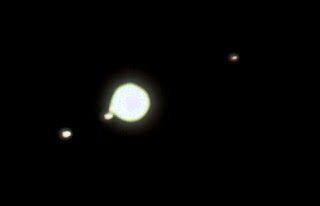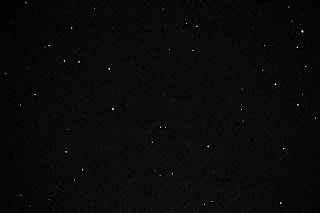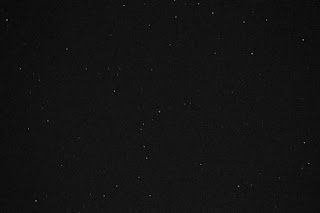May 27th 2130 GMT
Jupiter and the Moon were close. I took some frames at various ISO settings and exposure times at 300mm focal length to try to capture the most detail.First, I took the two objects together.
Then I caught the Moon on its own.
Then I caught Jupiter's moons and had a tough job removing the glare of the Moon.
Unfortunately, I was unable to remove the lunar glare, so this had to be the final result.
May 27th 1345 GMT
After
an unsuccessful attempt earlier, I managed to photograph a quiet sun in
hydrogen alpha light.
May 25th
I took some snaps of the Moon with my DSLR before bedtime.
May 23rd 1055 GMT
May 22nd 2135 GMT
I took a few frames of the Moon with my DSLR at 300mm focal length, ISO 100 and 1/1000 second exposure.May 21st 2030 GMT
Conditions were not perfect, with lots of moving cloud but it had seemed a long time since had used my Mak and DSLR to photograph the Moon. I took 38 frames at 1.54m focal length, ISO 100 and 1/100 second exposure.
May 19th 2230 GMT
It was dark but there was a lot o haze scattering the
moonlight. I took some light and dark frames of Jupiter with its moons.
May 19th 2125 GMT
The Moon was just about to disappear behind a tree, so I
took some full disc shots at 300mm focal length, ISO 100 and 1/500 second
exposure.
May 19th 0900 GMT
Again, the Sun was quiet but I managed to find some detail in hydrogen alpha light.
May 18th 0715 GMT
The
Sun seemed quiet and I could not see any more detail by tuning the etalon. Unfortunately, I did not capture any decent shots.
May 17th 2035 GMT
I was out and about and knew I would not be home before the
Moon set. I took a photo of it with Venus with my phone camera.
May 17th 0830 GMT
I could see some granulation on the Sun in hydrogen alpha
light but no features.
May 16th 2150 GMT
I tried to photograph Jupiter with its moons with my DSLR at
300mm focal length, ISO 6400 and 2 seconds exposure. I found that there was
lots of haze around Jupiter, so I tried some shorter exposures to see what
would happen. I removed some but not all of the haze.
I also tried a few shots of the Beehive (M44) and missed
totally but caught a few Cancer stars and thought I might have caught M67.
May 15th 0645 GMT
It
was clear but the Sun seemed quiet. I took a few full disc shots.
May 13th 0940 GMT
I
could see some granulation on the solar disc in hydrogen alpha light.
May 7th 1440 GMT
I could see some shading near the solar limbs but the Sun
was quiet, otherwise.
May 6th 0930 GMT
It
was warm and sunny. I did a hydrogen alpha shoot with my DSLR and PST. The sun
appeared quiet in the eyepiece but I could see some granulation in the camera
viewfinder.
May 5th 2220 GMT
I set up the camera at 70mm focal length, ISO 6400 and 7
seconds exposure and took several frames of Lyra. I took 74 light frames and 18 dark frames.
While waiting, I had a session with the review binoculars.
By the end, my arms were nearly dropping off, as they are quite heavy. At least
I had a great session. I started off with Jupiter and I used it to adjust
focus. The planet showed a small amount of red fringing but it was much more
sharp than I had ever seen through binoculars and I could see all four Galilean
moons, even though two were very close to the planetary disc. Lyra was about 20
degrees above the horizon. Epsilon split easily into two stars and so did
Delta. Despite the low elevation, I was able to see the Ring Nebula (M57),
usually a tough target for binoculars of this size (15x70). I was able to see
the Leo Triplet (of galaxies), which contain the spiral galaxies M65 and M66,
plus a slightly fainter galaxy whose name I forgot!
This encouraged me to have a go at the Virgo cluster and I
identified four fuzzy patches of light that were clearly neither comets nor
stars, so must have been galaxies. I was able to pot the globular star clusters
M13 and M92 in Hercules and M3 in Canes Venactici. I also saw the galaxy M51
there, plus M81 and M82 in Ursa Major. I tried to find the global star cluster
M5 in Serpens but my arms were too tired.
After a short rest, I could not resist the temptation to
look at the Beehive Cluster (M44) and Melotte 111, even though I had seen them
a few days before. They looked so good, I did not regret a second visit.
I moved the camera to aim for the Beehive cluster but I
could not make out in the viewfinder whether I had caught it or not. No I didn't but there were lots of stars east of Cancer.
I caught a meteor a few degrees east of the Beehive.
I changed to 300mm focal length and 2 seconds exposure on
Jupiter then took some dark frames.
May 5th 0810 GMT
The
Sun was quiet in hydrogen alpha light. While I was tuning my etalon, I saw an
aeroplane fly across the solar disc and leave a vapour trail.May 3rd 0750 GMT
The Sun was quiet but I had a go at photographing it in hydrogen alpha light anyway.May 2nd 2130 GMT
I missed the Sun because of work. I wanted to snap Leo, as I did not have a good shot of it. I took some photos with my old Konica Minolta at 18mm, ISO 800 and 30 seconds exposure. Unfortunately, I was unable to extract the photos from the camera.
I then took 2 sets of shots of Leo with my Nikon at 70mm,
ISO 6400 and 8 seconds exposure.
While checking the images, I found a sporadic meteor near Regulus. By checking the preceding and following image captures, I knew that it was not a satellite trail.
Now for the first Leo shot.
... and the second.

































No comments:
Post a Comment